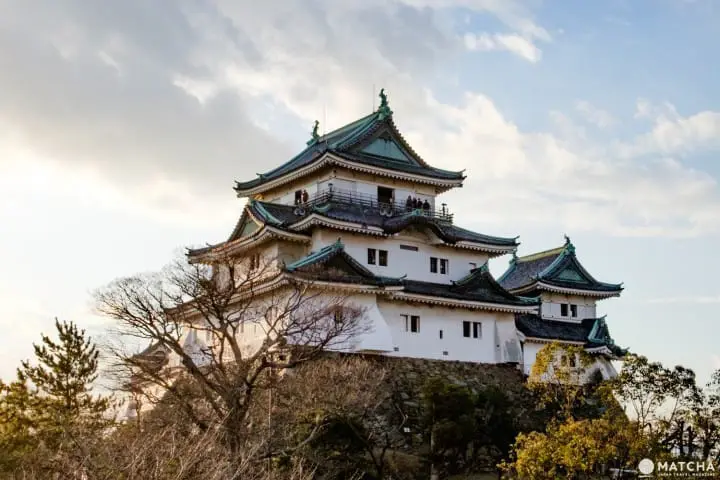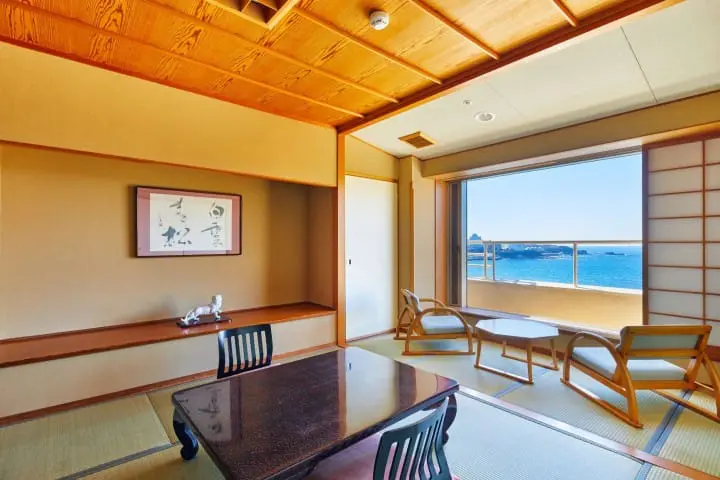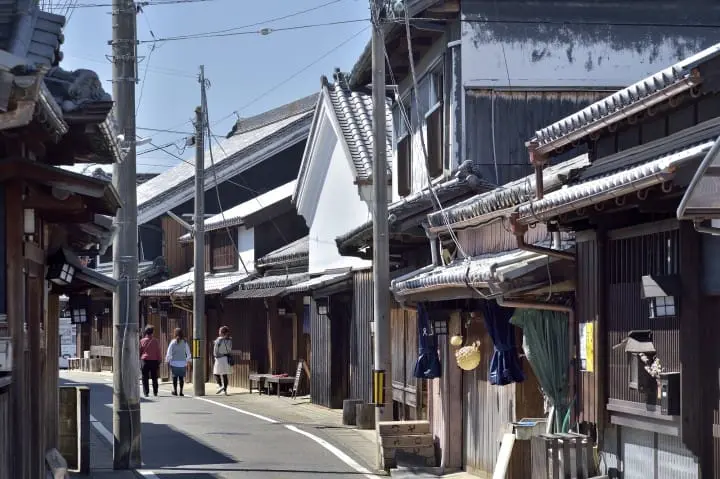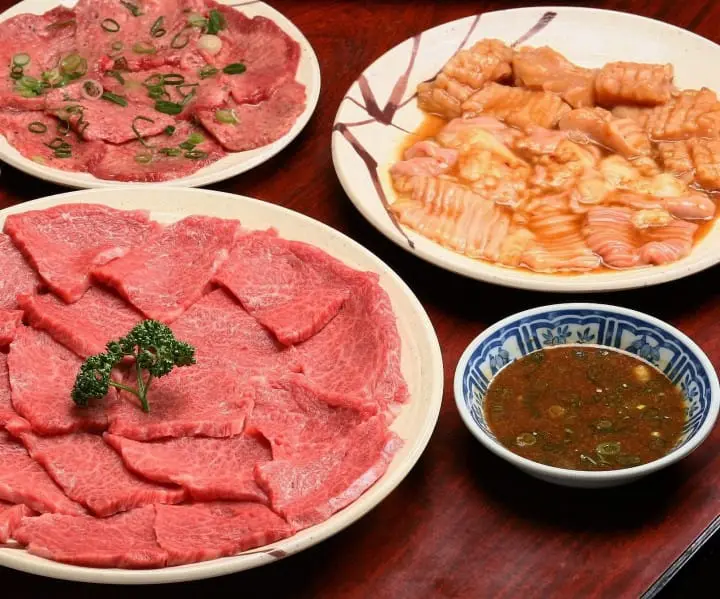Visit Wakayama - Shrines And Nature-Filled Spots, Things To Do, And Food

Wakayama in western Japan is ideal for those traveling in Osaka and Kyoto seeking respite from the busy city. This article introduces recommended places, like Mount Koya, things to do, and food, along with advice on transportation and weather.
Wakayama - Culture, Nature, and Regional Dishes
Located in western Kansai on the Kii Peninsula, Wakayama Prefecture is full of mountain ranges and gorgeous waters. A diversity of sights and sounds span across the different regions and delight all who visit.
Some of the most popular locations include the Sacred Sites and Pilgrimage Routes in the Kii Mountain Range and the Buddhist pilgrimage site of Mount Koya. Both have a sacred atmosphere unique to the region. Meanwhile, Shirahama Onsen by the coast is a must-experience hot spring destination known throughout Japan. The cuisine is another highlight, with Wakayama ramen and fresh seafood being staples of the prefecture.
Wakayama is a brilliant amalgamation of history, nature, and food in western Japan. This article covers the best places to visit in each area of the prefecture.
Wakayama Destinations, Activities, and Travel Tips
- ・5 Areas of Wakayama
- ・Things to Do in Wakayama City
- ・Things to Do on Mount Koya
- ・Things to Do in Kumano
- ・Things to Do in Shirahama and Kushimoto
- ・Things to Do in Kichu
- ・Wakayama Cuisine
- ・Weather and Seasons in Wakayama
- ・Transportation
5 Areas of Wakayama

Wakayama is divided into the following five areas: Wakayama City, Mount Koya, Kumano, Shirahama and Kushimoto, and Kichu. Each area is home to unique places and foods.
Wakayama City is full of history; Wakayama Castle is one of many ruins and landmarks dotting the city. The nearby coast offers excellent beaches and exquisite seafood to visitors. Wakayama Station is an hour train ride from Shin-Osaka Station, and Wakayama-shi Station is an hour via the Nankai Main Line from Namba Station.
Mount Koya is a sacred area with rich spiritual history. The mountain is a UNESCO World Heritage Site with grand temples and shrines on its slopes. The area is perfect for those wanting to relax while taking in Japan's nature and history. Staying overnight at the inns or pilgrim lodges is quite popular.
Kumano is another famous spiritual area in Wakayama. The Kumano Kodo, another World Heritage Site, is an ancient path that leads hikers through lush forests and rural western Japan to Ise Grand Shrine. Many natural hot springs along the trails offer a way to refresh after a day of walking.
The Shirahama and Kushimoto areas are great for relaxation. Shirahama Onsen is known as one of Japan's three most ancient hot springs, and its location on the water makes it look like a beach resort. Visitors can soak in the hot spring as they enjoy an ocean view.
Kichu retains the appearance of a 19th-century city. The sights of the area are ideal for photography and exploring.
Things to Do in Wakayama City
1. Wakayama Castle

Picture from Wakayama Castle Guide- Top 6 Spots For Enjoying Scenery And History
Wakayama Castle was home to the Kishu Tokugawa House, one of the Tokugawa Gosanke* during the Edo Period. As a landmark of Wakayama City, its main tower overlooks the city in every direction. The view in the early evening is particularly great for photographers.
This castle employs hospitality ninjas to take photos, provide guidance, help visitors in wheelchairs, and to make all feel welcome. There are in multiple languages (English, Korean, traditional and simplified Chinese) at Wakayama Castle.
*Gosanke: The three houses of Tokugawa were the highest-ranking elite dynasties under the Tokugawa regime.
2. Kishu Toshogu Shrine

Picture courtesy of Wakayama Tourism Federation, Public Interest Incorporated Association
Kishu Toshogu Shrine is a designated cultural property of Japan, built early in the Edo Period. Constructed in 1621 using the gongen-zukuri method,* this shrine is sometimes called Kansai's Nikko Toshogu Shrine.
Climb the 108 stone steps of the samurai-zaka incline to get a look at the elaborate decorations of the main hall. The walls are painted with vermilion lacquer and adorned with various ornaments and carvings. In addition to the shrine itself, the famous waters of Wakaura are a breathtaking sight.
*Gongen-zukuri: An architectural style found at certain shrines, in which the main hall and the worship hall are connected by a stone hallway.
Kishu Toshogu Shrine
Address: Wakayama, Wakayama, Wakauranishi, 2-1-20 Google Map
Access: 30 minutes by bus from JR Wakayama Station. Get off at Wakaura-guchi. Walk for 10 minutes.
Website: http://kishutoshogu.org/index.html (Japanese)
3. Kuroshio Market

Picture courtesy of Kuroshio Ichiba
Kuroshio Market, or Kuroshio Ichiba, is a part of Wakayama Marina City, famous for its tuna cutting show. The preparation of fresh tuna is exciting to see firsthand. After being prepared, the tuna is served as sushi and donburi. It is a rare opportunity to try fresh tuna.

Picture courtesy of Kuroshio Ichiba
Kuroshio Market has a Showa-era street market design. The cozy atmosphere is welcoming to all visitors.
The giant tuna sign and the tuna head are great for fun photos. Not only can you enjoy fresh seafood, but you can also walk around and take pictures of the market.
Kuroshio Market
Address: Wakayama, Wakayama, Kemi 1527 Google Map
Access: 30 minutes by bus from Nankai Wakayama Station and JR Wakayama Station
Website: http://www.marinacity.com/eng/ichiba/
4. Tomogashima

Ammunition chambers of the Third Battery. Photo by Pixta
Tomogashima is famous for its resemblance to "Laputa: Castle in the Sky," a popular Studio Ghibli film.
Four uninhabited islands make up the area: Jinoshima, Torajima, Kamijima, and Okinoshima. Okinoshima, in particular, has ruins of military bases used by Japan from the Meiji Period to World War II.
When you visit the island, we recommend seeing the ammunition chambers used by the Third Battery. The mossy brick ruins seem to transport you into the mystical world of Laputa. Make your way inside the dark tunnels for a unique experience.
The island is also a popular camping, picnic, and fishing site. We recommend it for anyone who loves the outdoors.
Tomogashima
Address: Wakayama, Wakayama, Miyama Google Map
Access: 20 minutes by ferry from Wakayama Kada Port
Website: http://tomogashimakisen.com/ (Japanese)
Things to Do on Mount Koya
5. Mount Koya

Picture from Relax At Guesthouse RICO In Wakayama – Experience The Warmth Of Rural Japan
Mount Koya is the head temple in Japan of Shingon Buddhism. With 1,200 years of history, this mountain is considered the mecca of Japanese Buddhism. The temple was founded by Kukai (also known as Kobo-Daishi), who strove to evangelize the Buddhist teachings he obtained in China.
One hundred and seventeen temples make up Mount Koya, and together they are officially called Kongobuji Head Temple.
The area contains 52 shukubo, or pilgrim lodges. From chanting sutra and worshiping in front of the image of Buddha (asagongyo) to trying Buddhist vegetarian cuisine (shojin ryori), these shukubo offer experiences unavailable at your typical hotel. It is an opportunity you cannot miss!
Read also
Things to Do in Kumano
6. Kumano Hongu Taisha Shrine

Picture courtesy of Wakayama Tourism Federation, Public Interest Incorporated Association
The Kumano Hongu Taisha Shrine is the head shrine of over 3,000 Kumano shrines in Japan. The Hongu Taisha, the Kumano Hayatama Taisha Shrine and the Kumano Nachi Taisha Shrine make up the Kumano Sanzan. In 2004, they were designated as a World Heritage Site.
Hongu Taisha is regarded in Japan as a shrine ideal for who are looking to start something new in their life. A visit will bring clarity and a refreshed point of view to visitors.
Follow the Kumano pilgrimage road and walk up the 158-step staircase to reach the main hall of the shrine. The shrine is filled with a mystical, sacred atmosphere.

Picture courtesy of Wakayama Tourism Federation, Public Interest Incorporated Association
When you visit the shrine, be sure to also see the Oyunohara, the original location of the shrine. It is thought to have been established in 1889.* At 34 meters, Japan's tallest torii is considered to possess special energy.
*The original location of the shrine is said to be where kami (deity) descended
Kumano Hongu Taisha Shrine
Address: Wakayama, Hongu, Hongu, Tanabe Google Map
Access: An hour bus ride from JR Shingu Station
Website: http://www.hongutaisha.jp/english/
7. Kumano Hayatama Taisha Shrine

Photo by Pixta
Pass through the beautifully lacquered torii to find another one of the Kumano Sanzan, the Kumano Hayatama Taisha Shrine.
A 1,000-year-old giant nagi tree grows on the shrine grounds. It is revered as a deity and is one of Japan's natural monuments. Due to its symmetrical leaves, the tree is said to strengthen marriages.
Kumano-goohoin, amulets to protect against disease and natural disasters, are sold at the Kumano Sanzan shrines. The charms have crow pictographs, as crows have a close connection with the Kumano deities. They make a unique way to remember the gorgeous shrine.

Photo by Pixta
A short ten-minute walk away is Kamikura Shrine. Legend has it that the Kumano deity first descended on earth here, and as a result, the shrine is considered sacred land with mystical powers.
The venerated Kotobiki Rock looms above the shrine, making for a commanding view.
To reach Kamikura Shrine requires climbing a steep stone staircase. We highly advise you to wear sneakers or shoes that are easy to walk in.
Kumano Hayatama Taisha Shrine
Address: Wakayama, Shingu, Shingu 1 Google Map
Access: 15 minutes on foot from JR Shingu Station
Website: http://kumanohayatama.jp/ (Japanese)
8. Kumano Nachi Taisha Shrine

Picture courtesy of Wakayama Tourism Federation, Public Interest Incorporated Association
At the top of 467 steps is the vermilion shrine of Kumano Nachi Taisha. The shrine is thought to enshrine Kumano-fusumino-okami, a Japanese deity of marriage.
Located at 330 meters above sea, the shrine provides a breathtaking view of the mountain landscape.
When you visit Nachi Taisha, you can experience Japan's largest omikuji. For 100 yen you can draw from the 133-centimeter long omikuji box. It is a one-of-a-kind experience.
Kumano Nachi Taisha Shrine
Address: Wakayama, Higashimuro, Nachi Katsuura, Nachisan 1 Google Map
Access: 30 minutes by bus from JR Kii Katsuura Station
Website: http://kumanonachitaisha.or.jp/ (Japanese)
9. Nachi Falls

Picture from Relax At Guesthouse RICO In Wakayama – Experience The Warmth Of Rural Japan
Be sure to walk down to Nachi Falls from Nachi Shrine. Called Ichi-no-taki, it is an important waterfall among the 48 located in Nachi Forest. The water cascades from 133 meters high, making it the greatest single drop in Japan.
Nachi Falls itself is a deity at Hiro Shrine. When you come to visit and make a prayer, face the waterfall. The fall is close to the Hiro Shrine gates; the mystical atmosphere here will make you feel as if your soul is being cleansed.
Nachi Falls
Address: Wakayama, Nachikatsuura, Higashimuro, Nachisan Google Map
Access: 30 minutes by bus from JR Kii Katsuura Station
Website: http://kumanonachitaisha.or.jp/pavilion/waterfall.html (Japanese)
10. Kumano Kodo

Photo by Pixta
The Kumano Kodo is a set of sacred paths used for pilgrimage to the Kumano Sanzan from Antiquity to the Middle Ages. Its three courses--Nakahechi, Ohechi, and Kohechi--are a designated World Heritage Site.
Since it is a path, most people hike along the trails. With various difficulties of courses, the Kumano Kodo is ideal for both beginners and advanced hikers. The most popular is the seven-kilometer course that takes you along a relatively easy path to Kumano Hongu Taisha Shrine. This is a recommended course for first-time visitors.
If you are new to hiking entirely, we suggest trying a three-kilometer course to Nachi Falls. The stone steps that lead up to the Kumano Nachi Taisha Shrine are a mystical, one-of-a-kind experience. Make your visit more fun by soaking in the Nanki-Katsuura hot springs neaby.
Trailheads
Address (7-km course): Wakayama, Tanabe, Kamikikubo Hongu, Mitsukoshi 1652 Google Map
Address (3-km course): Wakayama, Higashimuro, Nachikatsuura, Nachisan 392 Google Map
Website: http://www.hongu.jp/en/kumano-kodo/
11. Katsuura Gyoko Nigiwai Market

Picture courtesy of Nigiwai Ichiba
In 2018, the Katsuura Gyoko Nigiwai Market, known for its exquisite tuna, was incorporated to the Nachi-Katsuura Fishing Port, a harbor boasting Japan's largest catch of the fish. At the market, you can try fresh seafood and buy local Wakayama products.
Eight restaurants serve a plethora of dishes using tuna, from sashimi and sushi to deep-fried cutlets. We recommend taking your meal out onto the wooden deck, enjoying your food as you look out at the sea. The live tuna preparation is another highlight of the market.
Katsuura Gyoko Nigiwai Ichiba
Address: Wakayama, Higashimuro, Nachikatsuura, Tsukiji 7-12 Google Map
Access: 10 minutes on foot from Kii Katsuura Station
Website: http://nigiwaiichiba.com/ (Japanese)
12. Hashiguiiwa Rocks

Hashiguiiwa Rocks is a 850-meter-long line of forty boulders that stand in shallow waters. The name comes from their resemblance to the piles of a bridge. The strange sight is the result of years of water erosion.
Standing in a cobalt blue sea with a vast clear sky in the background, Hashiguiiwa is a popular spot to watch the sunrise. The sun poking out from between the boulders is a gorgeous sight to behold. We especially recommend the place for photographers.
Hashiguiiwa Rocks
Address: Wakayama, Higashimuro, Kushimoto, Kujinokawa 1549-8 Google Map
Access: 7 minutes by car from Kushimoto Station
Website: https://www.kkr.mlit.go.jp/road/michi_no_eki/contents/wakayama/hasiguiiwa.html (Japanese)
Things to See in Shirahama and Kushimoto
13. Shirahama Onsen

17th-floor balcony bath of Kishu Shirahama Onsen Musashi. Picture courtesy of Kishu Shirahama Onsen Musashi.
Shirahama Onsen (*1) is a must-visit resort spot in the Shirahama area. It is designated as one of Japan's three ancient springs, along with Dogo Onsen and Arima Onsen.

Picture courtesy of Kishu Shirahama Onsen Musashi
Kishu Shirahama Onsen Musashi, the only Japanese ryokan (*2) at the resort, allows guests to soak in the therapeutic waters and 1,300 years of history. The high-quality spring, combined with the breathtaking view, will help relieve your body of aches. The waters are said even to help improve chronic health conditions.
At Saki-no-yu, you do not need to stay overnight to use the onsen. Come here to soak in the outdoor bath with an expansive view of the Pacific Ocean.
14. Engetsu Island

Engetsu Island is a famous landmark of Shirahama. The island's official name is Takashima, but is more well-known as Engetsu (meaning "Circle Moon") Island because of the round hole in its center. The island is a popular spot during sunset, and is considered one of Japan's 100 best sunset locations.
An observation platform a 20-minute walk from the Shirarahama Parking Lot offers a great view of Engetsu Island. It is an ideal spot to watch the sun set behind the island and sink below the sea. You can also enjoy the ocean life around the island aboard the Glass Boat or soak your feet at the Mifune-Ashiyu foot bath.
Engetsu Island
Website: http://www.nanki-shirahama.net/sightseeing/
15. ToreTore Market

Picture courtesy of ToreTore Ichiba
Enjoy quality seafood at ToreTore Market, the largest seafood market in western Japan. Fresh fish from across the country are delivered every day.
At the market's food court, ToreTore Yokocho, you can savor different seafood dishes--seafood bowls, sashimi, sushi, and grilled fish, among others. A wide array of gifts are also being sold, such as local sake and desserts.
ToreTore Market
Address: Wakayama, Nishumuro, Shirahama, Katata 2521 Google Map
Access: 5 minutes by car from JR Shirahama Station
Website: https://toretore.com/en/
16. Shirarahama Beach

Picture courtesy of Wakayama Tourism Federation, Public Interest Incorporated Association
The vast 620-meter Shirarahama Beach rivals the best tropical resorts. With 600,000 visitors annually, it is one of the most popular beaches in the Kansai region.
The white sand, palm trees, and emerald green water here strongly resemble its sister beach of Waikiki. During the summer, the beach comes alive with many visitors and colorful parasols. From fireworks in the summer to illuminations in the winter, special events are held year-round.
Shirarahama Beach
Address: Wakayama, Nishimuro, Shirahama 864 Google Map
Access: 15 minutes on the Meiko Bus from JR Shirahama Station
Website: http://www.town.shirahama.wakayama.jp/kanko/midokoro/1454401113276.html (Japanese)
Things to Do in Kichu
17. Yuasa

Photo by Pixta
A historic lodging town for those embarking on the Kumano Kodo, Yuasa remains a gorgeous town. It boasts a traditional Japanese atmosphere, with 19th-century buildings lining the street. The town is also famous for inventing soy sauce, with ninety breweries existing here in the early 19th century.
Be sure to bring your camera, stroll down the traditional streets, and learn about the history of soy sauce.
Start on Kitamachi-dori Street, where you will find the longstanding soy sauce brewery Kadocho and the museum Jinburo. You are sure to encounter the rich history and tradition of Yuasa.
Yuasa
Address: Wakayama, Arida, Yuasa Google Map
Access: 90 minutes on the Kuroshio Express from JR Shin-Osaka Station
Website: http://www.town.yuasa.wakayama.jp.e.ze.hp.transer.com/
Wakayama Cuisine
Wakayama Ramen

Picture courtesy of Wakayama Tourism Federation, Public Interest Incorporated Association
A staple of Wakayama is its ramen, often called "chuka soba" by locals. Wakayama ramen is known for its thin, delicious noodles. There are two types of broth: one with a smooth, soy sauce base, and one with rich mix of tonkotsu (pork) and soy sauce.
You will first receive hayazushi, or bite-sized mackerel sushi when you sit down at ramen restaurants in Wakayama. It is the perfect appetizer to snack on while you wait for your order and goes great with a bowl of ramen.
We recommend Marutaya. They serve high-quality ramen and also have superior customer service.
Other local delicacies to try are roasted pork musubi (*1) wrapped in dried nori seaweed from Tomogashima, and a fresh whitebait rice bowl.
*1 Musubi: a rice ball
Kumano Beef

Picture courtesy of Yakiniku Hige
Kumano beef is a type of wagyu beef from cows raised in southern Wakayama's Kumano region. Smooth and soft in texture, Kumano beef gives off a delicious aroma when grilled.
Yakiniku Hige, a fifteen-minute walk from Shingu Station, is a yakiniku* restaurant recognized officially for its exquisite wagyu. Its in-house special sauce makes a perfect match for the meat.
We also recommend Hinoki Steak House, a seven-minute walk from Kii-Katsuura Station. Since its founding in 1972, this restaurant has served 100% Kumano beef Hamburg steaks. They cook the meat to your liking.
*Yakiniku: Japanese barbecue
Seafood

Mochi tuna bowl. Picture courtesy of Nigiwai Ichiba
Seafood is a must in a prefecture surrounded by a beautiful ocean. Tuna and grouper are especially delicious choices. Tuna is best from winter to spring when its meat is the fattiest and most satisfying. You can try tuna sashimi and sushi at Nigiwai Market located at Katsuura Fishing Port.
Grouper, a prized type of sea bass, is in-season from October to December. The thick skin and meat around the bones is a delicacy.
Mehari Sushi

Picture courtesy of Wakayama Tourism Federation, Public Interest Incorporated Association
Mehari sushi, a type of Kumano dish, is a rice ball wrapped in pickled mustard leaves, flavored with a soy sauce-based sauce. It is thought to have originated in the 7th century when woodcutters combined rice balls and pickles for a quick lunch. Some call mehari sushi Japan's first fast-food meal.
You can try freshly-made mehari sushi at the restaurant Mehariya. Their main location is in Shingu, with a second store in Wakayama. The restaurant also sells kits to make mehari sushi at home.
Weather and Seasons in Wakayama

Picture from Weather In Kyoto And Osaka In September-October: What To Wear?
With the central Kii Mountain Range of 1,000 meters, Wakayama Prefecture is 80% mountain. The average temperature from January to February is 6°C. From May to June, the temperature goes over 20°C and rises to over 30°C between July and September. Fortunately, the ocean breeze helps to mitigate the summer heat.
In October, the temperature will fall below 20°C for an ideal autumn climate. Temperatures continue to drop to 15°C in November and to 10°C in December. Make sure to bring a coat.
See Summer Festivals - Ogi Matsuri

Picture courtesy of Wakayama Tourism Federation, Public Interest Incorporated Association
If you visit in July, we recommend going to the Nachi Ogi Festival. Held every year on July 14 at Kumano Nachi Taisha Shrine, this festival is synonymous with summer in Wakayama. Twelve ogi-mikoshi,* each 6 meters tall, are carried by participants from Nachi Taisha to Nachi Falls.
Leading the mikoshi procession is an otaimatsu, a giant torch that weighs over 50 kilograms. Witness men dressed in all white carry the otaimatsu down the pilgrimage path.
*Mikoshi: portable shrine
Transportation

Tour bus in Wakayama. Picture courtesy of Wakayama Tourism Federation, Public Interest Incorporated Association
The best way to get around Wakayama is by train or local bus. We recommend purchasing the visitor's pass for Ise, Kumano, and Wakayama. This pass will give you unlimited access to Japan Railway (JR) lines, express trains, buses, and local trains.
The pass covers a large area: JR routes along the Wakayama coast, central Osaka to Kansai Aiport, Nara, Nagoya, and the Ise region in Mie.
If you purchase the pass in Japan, it will run you 12,000 yen per adult. If you buy it online ahead of time, it costs 11,000 yen.
An express train will take you from Wakayama City to Shirahama and Kushimoto in two hours. It is a 90-minute to a two-hour ride from Shirahama-Kushimoto to Kumano's Kii-Katsuura, Nachi, and Shingu areas.
Wakayama - Take in the Outdoors, Seafood, and Local History
Make your way to Wakayama after visiting Kyoto and Osaka! From the mystical Kumano Kodo and Mount Koya to the Shirahama beach and onsen to the seafood markets, Wakayama offers many unforgettable experiences.
This is the official account of MATCHA's editorial department. Our articles feature useful travel information for visitors to Japan, from how-to guides to recommended places to visit.
















































![[Just a short distance from Nagoya] Popular Taiwanese YouTuber Alan tours Aichi, Tokoname!](https://resources.matcha-jp.com/resize/720x2000/2026/01/08-255181.webp)

